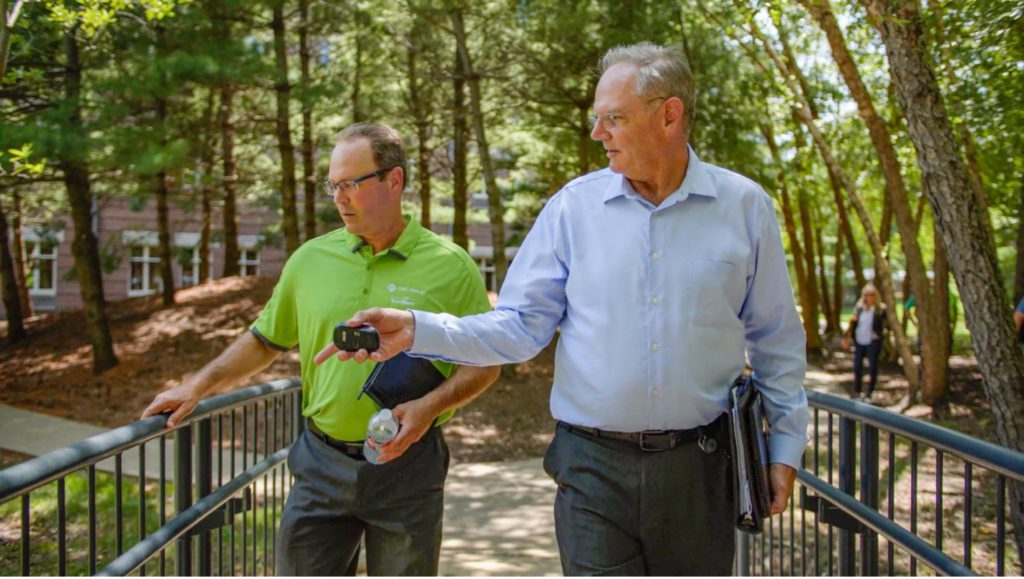
With each customer we’ve partnered with, we’ve gained a deeper understanding of their unique needs, challenges, and goals. Along the way, we’ve gained invaluable insight and learned some critical lessons that guide our approach to every project.
Here are the major lessons we’ve learned:
- Assemble all stakeholders: Whether in the same room or on a virtual conference call, all stakeholders must get together to outline everyone’s goals and objectives. This group should include the facility owner, the property management team managing the facilities, and the manufacturer (in this case, Schneider Electric).
Make these at least monthly meetings to follow approval processes and highlight progress, obstacles or red flags, and the paths forward.
- Identify and evaluate project goals and priorities: This includes the goals of everyone at the table, such as target energy savings, sustainability goals, indoor air quality improvements, and even other elements that may initially seem outside the project but could provide overall sustainability benefits.
For example, a building control upgrade is an ideal opportunity to consider adding sustainability and energy savings strategies to the upgrade. You’re already there, your tools are there, and you’ve already “opened the hood.” It’s the perfect time for your customers to consider their long-term decarbonization and sustainability goals as they perform other control upgrades.
- Walk the facility: Getting boots on the ground is key – it highlights the starting points for your upgrades – essentially a bottom-up approach – and identifies areas of improvement while prioritizing upgrades. And it’s the perfect chance to evaluate each key component individually to determine its ability to communicate with the sustainability and analytics software.
- Develop an implementation plan: Create a detailed plan for implementing the upgrades, including a timeline, budget, and resource requirements. Then, select upgrades based on the goals and priorities from Step 2. This could include HVAC upgrades, digitized electrical infrastructure, lighting retrofits, building or power management and automation systems, or renewable energy installations.
- Install facility upgrades: Once a plan is in place, the energy management and building automation experts will drive the installation and commissioning efforts to ensure successful implementation and delivery of expected results.
- Monitor and Measure Performance: A crucial part of sustainability efforts is tracking the performance of the upgrades and ensuring that they meet the expected goals and priorities. Regularly monitoring and analyzing facility performance identifies areas that need improvement and implement corrective measures. It also enables tracking of the return on sustainability investments (ROI).
- Continuously Improve: Sustainability and decarbonization are not a ‘one-and-done’ achievement. Instead, it’s an ongoing process. Continuous evaluation helps improve the facility’s performance to ensure they meet goals and priorities over time. It also helps ensure that the improvements continue to deliver the desired benefits, such as reduced energy consumption, improved indoor air quality, and enhanced occupant comfort and productivity.
- Communicate Results: Celebrate your success! Communicate the results of the upgrades to building occupants, stakeholders, and the wider community to showcase the benefits of the upgrades and inspire further action toward sustainability and energy efficiency.
By following these eight steps, your team will have a clear roadmap to success as they pursue their energy, sustainability, or carbon reduction goals.
Strong partnerships lead to excellent results
Our experience has taught us that listening carefully, applying our expertise, and communicating openly are essential elements of building successful, long-term relationships with our customers. We’re grateful for the opportunity to have learned from our customers, and we’re committed to applying these lessons to continue delivering exceptional value and service.
We are also proud to work with Schneider Electric and leverage its expertise and technology. Contact Advanced Control Corp today to find more about sustainable building solutions!
Published with permission from Schneider Electric.

